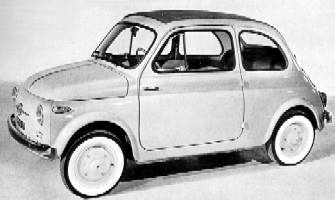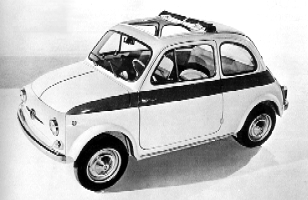By Peter Jones
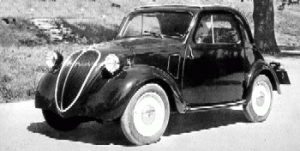 1936 saw the birth of the Fiat Cinquecento better known by its nick name “The Topolino” – that’s Mickey Mouse to you. This car, the brilliant design of Dante Giacosa, sold for less than 10,000 Lire and introduced thousands of people to motoring, something they had previously thought they might never be able to afford. The engine, a side valve 569cc unit producing 13 bhp at 4000 rpm giving a top speed of 53 m.p.h, was situated in the front of the car with conventional transmission to the rear wheels. The car continued in production until after the Second World War when in 1948 at the Geneva Motor Show the 500B appeared. The body was virtually unchanged but the engine was new. It had exactly the same cubic capacity 596cc but with overhead valves, this resulted in an increase of 3 bhp to 16.5 bhp with an improved top speed of 59 mph.
1936 saw the birth of the Fiat Cinquecento better known by its nick name “The Topolino” – that’s Mickey Mouse to you. This car, the brilliant design of Dante Giacosa, sold for less than 10,000 Lire and introduced thousands of people to motoring, something they had previously thought they might never be able to afford. The engine, a side valve 569cc unit producing 13 bhp at 4000 rpm giving a top speed of 53 m.p.h, was situated in the front of the car with conventional transmission to the rear wheels. The car continued in production until after the Second World War when in 1948 at the Geneva Motor Show the 500B appeared. The body was virtually unchanged but the engine was new. It had exactly the same cubic capacity 596cc but with overhead valves, this resulted in an increase of 3 bhp to 16.5 bhp with an improved top speed of 59 mph.
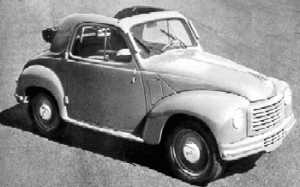 The 500B Giardiniera also made its first appearance and the body work was based on American Station Wagon styling. Steel, timber and laminated plastic sheet were used in its construction and it one of the better looking Topolinos. In 1949 only one year after its first update, it was changed again this time the body received the treatment. The front and back were changed and, in my opinion, not improved. The Giardiniera also had the front modified whilst the engine received an aluminium head and the interior was given a heating/demisting system, the first fitted as standard on any Fiat.
The 500B Giardiniera also made its first appearance and the body work was based on American Station Wagon styling. Steel, timber and laminated plastic sheet were used in its construction and it one of the better looking Topolinos. In 1949 only one year after its first update, it was changed again this time the body received the treatment. The front and back were changed and, in my opinion, not improved. The Giardiniera also had the front modified whilst the engine received an aluminium head and the interior was given a heating/demisting system, the first fitted as standard on any Fiat.
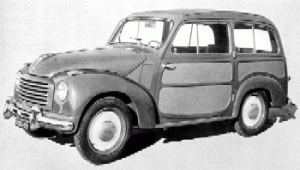 The last incarnation of the Topolino was the replacement of the Giardiniera by the Belvedere, the body of which was all metal and it looked a very utilitarian vehicle. 1955 saw the end of the run. The Fiat 600 it seemed was to be its replacement. It was offered at a lower price than the Topo and was the first rear engined Fiat. Actually, if we thought that the 600 was the Topos replacement, we thought wrong because in the summer of 1957 the new 500 showed its face and it was hoped that it would repeat the success of its great ancestor. It had the latest design techniques, such as integral body chassis structure, all round independent suspension and a rear engine. The engine was an air cooled 2-cylinder unit, the first ever employed by Fiat. The car did not receive the welcome that Fiat had hoped for, so very soon there was increased power available plus improved body features. In 1958 the New 500 Sport came on the scene, it had a sunshine roof, two-tone paint and was then capable of 65 m.p.h.
The last incarnation of the Topolino was the replacement of the Giardiniera by the Belvedere, the body of which was all metal and it looked a very utilitarian vehicle. 1955 saw the end of the run. The Fiat 600 it seemed was to be its replacement. It was offered at a lower price than the Topo and was the first rear engined Fiat. Actually, if we thought that the 600 was the Topos replacement, we thought wrong because in the summer of 1957 the new 500 showed its face and it was hoped that it would repeat the success of its great ancestor. It had the latest design techniques, such as integral body chassis structure, all round independent suspension and a rear engine. The engine was an air cooled 2-cylinder unit, the first ever employed by Fiat. The car did not receive the welcome that Fiat had hoped for, so very soon there was increased power available plus improved body features. In 1958 the New 500 Sport came on the scene, it had a sunshine roof, two-tone paint and was then capable of 65 m.p.h.
1960 the Station Wagon was reintroduced and again called the “Giardiniera”. In order to keep the load space the engine was mounted underneath on its side. The saloon was now designated the 500D, it had the 500 Sport engine which increased the power by about 1 Bhp. This ended the 500 Sport.
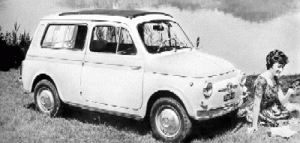 In March 1965 more modifications were made to the car now to be known as the 500F. The main change to the bodywork was the adoption of front hinged doors whilst the performance remained virtually unchanged.
In March 1965 more modifications were made to the car now to be known as the 500F. The main change to the bodywork was the adoption of front hinged doors whilst the performance remained virtually unchanged.
1968 saw the introduction of the 500 De Luxe to be called the 500L (L for Lusso Luxury (!)). Internally the car was to be completely redesigned and externally more bright work appeared. The other upgrade was the addition of Radial ply tyres.
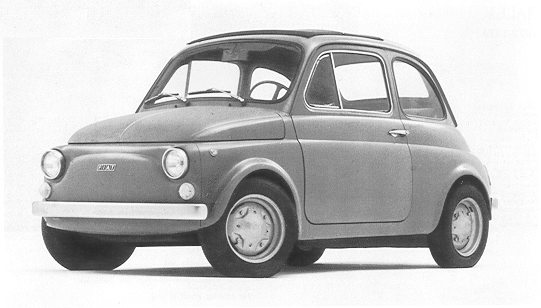 1972 as far as the UK is concerned was the end of things, the 500 having been replaced by the 126. In Europe the 500 continued for 3 more years with the designation 500R. This model had a slightly detuned version of the 126 594cc engine plus a different badge on the front of the car and no overriders. It also had 126 wheels. 1975 saw the end of the 500 production. Since 1957 about 4 million 500s were produced and in Italy today a whole cottage industry has sprung up to keep a great many of these 4 million cars alive.
1972 as far as the UK is concerned was the end of things, the 500 having been replaced by the 126. In Europe the 500 continued for 3 more years with the designation 500R. This model had a slightly detuned version of the 126 594cc engine plus a different badge on the front of the car and no overriders. It also had 126 wheels. 1975 saw the end of the 500 production. Since 1957 about 4 million 500s were produced and in Italy today a whole cottage industry has sprung up to keep a great many of these 4 million cars alive.
During the course of this little car’s life, there has been special tuning versions by Abarth and Gianini and every amateur tuning expert that walks on two legs! The most common of these is the fitment of 126 running gear through to Rover V8 engines. For reasons I don’t properly understand, people have contacted me for advice on the fitment of these Rover V8 engines into the 500. My reply is always the same; I know it can be done because I have seen it done but please don’t try it because it seems a very dangerous idea to me. There have also been a number of special bodied versions by such people as Vignale and Autobianchi plus many more. The 500 story goes on and on and will probably outlive the lot of us.

![Fiat Motor Club [GB]](https://fiatmotorclubgb1.netfirms.com/wp-content/uploads/2017/11/Website-Header-v3.jpg)
